The AMD Radeon R9 290X Review
by Ryan Smith on October 24, 2013 12:01 AM EST- Posted in
- GPUs
- AMD
- Radeon
- Hawaii
- Radeon 200
GRID 2
The final game in our benchmark suite is also our racing entry, Codemasters’ GRID 2. Codemasters continues to set the bar for graphical fidelity in racing games, and with GRID 2 they’ve gone back to racing on the pavement, bringing to life cities and highways alike. Based on their in-house EGO engine, GRID 2 includes a DirectCompute based advanced lighting system in its highest quality settings, which incurs a significant performance penalty but does a good job of emulating more realistic lighting within the game world.
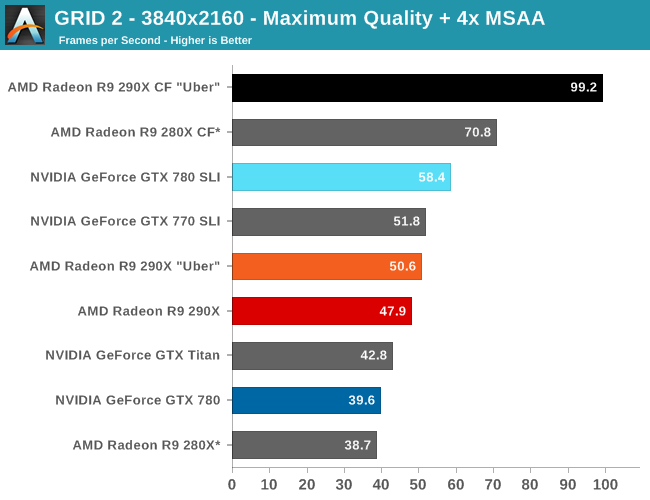
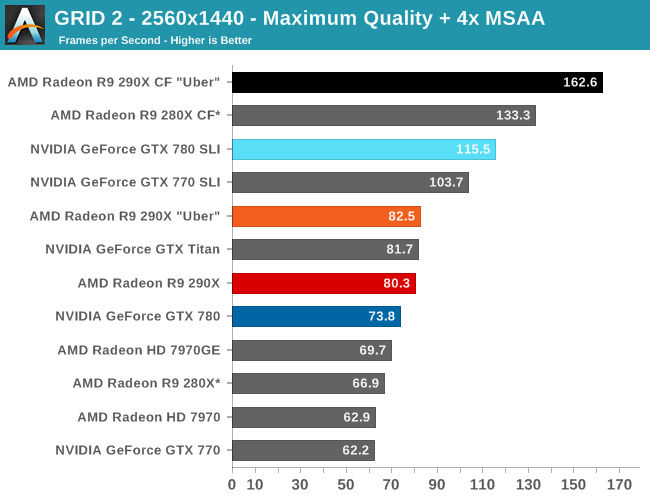
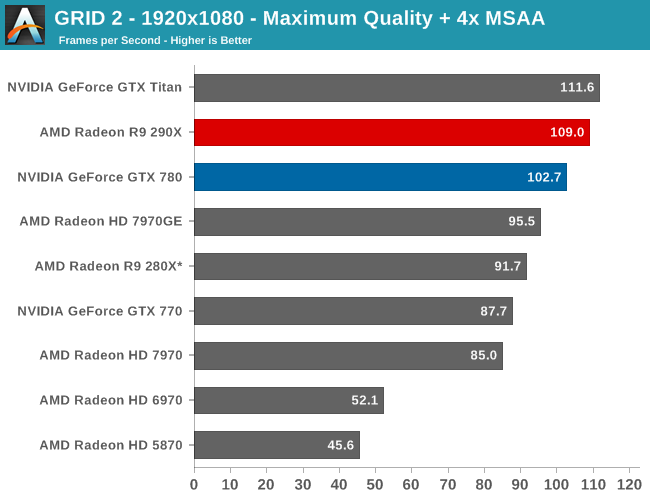
For as good looking as GRID 2 is, it continues to surprise us just how easy it is to run with everything cranked up, even the DirectCompute lighting system and MSAA (Forward Rendering for the win!). At 2560 the 290X has the performance advantage by 9%, but we are getting somewhat academic since it’s 80fps versus 74fps, placing both well above 60fps. Though 120Hz gamers may still find the gap of interest.
Moving up to 4K, we can still keep everything turned up including the MSAA, while pulling off respectable single-GPU framerates and great multi-GPU framerates. To no surprise at this point, the 290X further extends its lead at 4K to 21%, but as usually is the case you really want two GPUs here to get the best framerates. In which case the 290X CF is the runaway winner, achieving a scaling factor of 96% at 4K versus NVIDIA’s 47%, and 97% versus 57% at 2560. This means the GTX 780 SLI is going to fall just short of 60fps once more at 4K, leaving the 290X CF alone at 99fps.
Unfortunately for AMD their drivers coupled with GRID 2 currently blows a gasket when trying to use 4K @ 60Hz, as GRID 2 immediately crashes when trying to load with 4K/Eyefinity enabled. We can still test at 30Hz, but those stellar 4K framerates aren’t going to be usable for gaming until AMD and Codemasters get that bug sorted out.
Finally, it’s interesting to note that for the 290X this is the game where it gains the least on the 280X. The 290X performance advantage here is just 20%, 5% lower than any other game and 10% lower than the average. The framerates at 2560 are high enough that this isn’t quite as important as in other games, but it does show that the 290X isn’t always going to maintain that 30% lead over its predecessor.
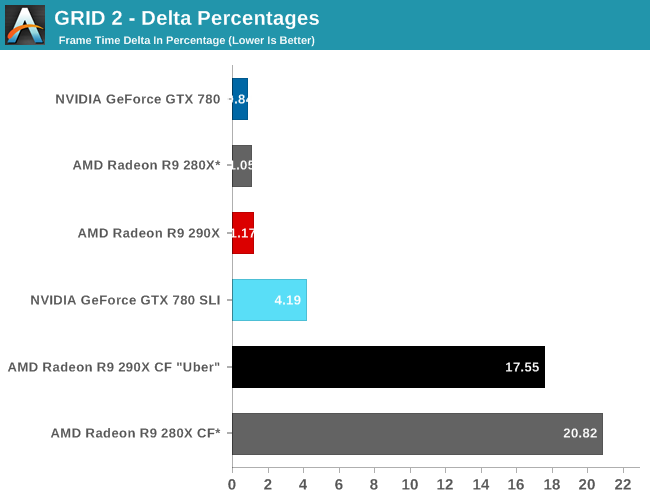
Without any capturable 4K FCAT frametimes, we’re left with the delta percentages at 2560, which more so than any other game are simply not in AMD’s favor. The GTX 780 SLI is extremely consistent here, to the point of being almost absurdly so for a multi-GPU setup. 4% is the kind of variance we expect to find with a single-GPU setup, not something incorporating multiple GPUs. AMD on the other hand, though improving over the 280X by a few percent, is merely adequate at 17%. The low frame times will further reduce the real world impact of the difference between the GTX 780 SLI and 290X CF here, but this is another game AMD could stand some improvements, even if it costs AMD some of the 290X’s very strong CF scaling factor.


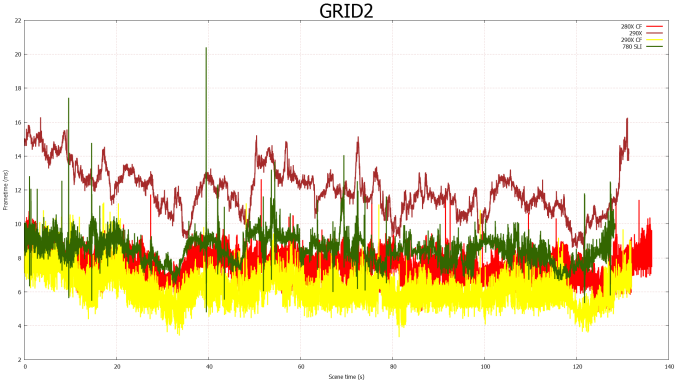








396 Comments
View All Comments
TheJian - Friday, October 25, 2013 - link
Incorrect. Part of the point of gsync is when you can do 200fps in a particular part of the game they can crank up detail and USE the power you have completely rather than making the whole game for say 60fps etc. Then when all kinds of crap is happening on screen (50 guys shooting each other etc) they can drop the graphics detail down some to keep things smooth. Gsync isn't JUST frame rate. You apparently didn't read the anandtech live blog eh? You get your cake and can eat it too (stutter free, no tearing, smooth and extra power used when you have it available).MADDER1 - Friday, October 25, 2013 - link
If Gsync drops the detail to maintain fps like you said, then you're really not getting the detail you thought you set. How is that having your cake and eating it too?Cellar Door - Friday, October 25, 2013 - link
How so? If Mantle gets 760gtx performance in BF4 from a 260X ..will you switch then?Animalosity - Sunday, October 27, 2013 - link
No. You are sadly mistaken sir.Antiflash - Thursday, October 24, 2013 - link
I've usually prefer Nvidia Cards, but they have it well deserved when decided to price GK110 to the stratosphere just "because they can" and had no competition. That's poor way to treat your customers and taking advantage of fanboys. Full implementation of Tesla and Fermi were always priced around $500. Pricing Keppler GK110 at $650+ was stupid. It's silicon after all, you should get more performance for the same price each year. Not more performance at a premium price as Nvidia tried to do this generation. AMD is not doing anything extraordinary here they are just not following nvidia price gouging practices and $550 is their GPU at historical market prices for their flagship GPU. We would not have been having this discussion if Nvidia had done the same with GK110.inighthawki - Thursday, October 24, 2013 - link
" It's silicon after all, you should get more performance for the same price each year"So R&D costs come from where, exactly? Not sure why people always forget that there is actual R&D that goes into these types of products, it's not just some $5 just of plastic and silicon + some labor and manufacturing costs. Like when they break down phones and tablets and calculate costs they never account for this. As if their engineers are basically just selecting components on newegg and plugging them together.
jecastejon - Thursday, October 24, 2013 - link
R&D. Is R&D tied only to a specific Nvidia card? AMD as others also invest a lot in R&D with every product generation, even if they are not successful. Nvidia will have to do a reality cheek with their pricing and be loyal to their fans and the market. Today's advantages don't last for to long.Antiflash - Thursday, October 24, 2013 - link
NVIDIA's logic. Kepler refresh: 30% more performance => 100% increase in priceAMD's logic. GCN refresh: is 30% more preformance => 0% increase in price
I can't see how this is justified by R&D of just a greedy company squishing its more loyal customer base.
Antiflash - Thursday, October 24, 2013 - link
Just for clarification. price comparison between cards at its introduction comparing NVIDIA's 680 vs Titan and AMD's 7970 vs 290xTheJian - Friday, October 25, 2013 - link
AMD way=ZERO PROFITS company going broke, debt high, 6Bil losses in 10yrsNV way=500-800mil profits per year so you can keep your drivers working.
Your love of AMD's pricing is dumb. They are broke. They have sold nearly everything they have or had, fabs, land, all that is left is the company itself and IP.
AMD should have priced this card at $650 period. Also note, NV hasn't made as much money as 2007 for 6 years. They are not gouging you or they would make MORE than before in 2007 right? Intel, Apple, MS are gouging you as they all make more now than then (2007 was pretty much highs for a lot of companies, down since). People like you make me want to vomit as you just are KILLING AMD, which in turn will eventually cost me dearly buying NV cards as they will be the only ones with real power in the next few years. AMD already gave up the cpu race. How much longer you think they can fund the gpu race with no profits? 200mil owed to GF in Dec 31, so the meager profit they made last Q and any they might have made next Q is GONE. They won't make 200mil profit next Q...LOL. Thanks to people like you asking for LOW pricing and free games.
You don't even understand you are ANTI-AMD...LOL. Your crap logic is killing them (and making NV get 300mil less profit than 2007). The war is hurting them both. I'd rather have AMD making 500mil and NV making 1B than what we get now AMD at ZERO and NV at 550mil.